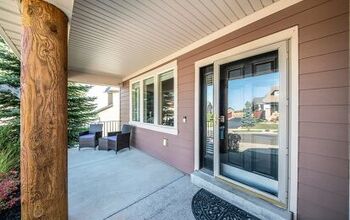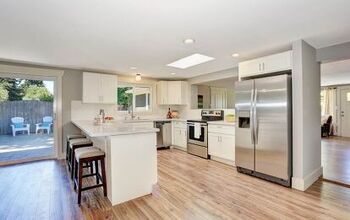Passage Vs. Privacy Door Knob: What Is The Major Difference?

Choosing the right doorknob is just as important as choosing the right type of door. Doorknobs are a crucial aspect of security, privacy, safety, and convenience within your home. So, what is the difference between passage and privacy doorknobs?
Privacy doorknobs lock on one side and are typically found in bathrooms and bedrooms. Passage doorknobs don’t have a locking mechanism, but they provide easy access between rooms in the home. Never install a passage doorknob on an exterior door unless you install a deadbolt to improve the security.
It can be dangerous to put a privacy doorknob on a baby or child’s bedroom in the event of an emergency. Both passage and privacy doorknobs have their place in the home, but privacy doorknobs are more secure. Follow along as we explore the differences between passage and privacy doorknobs.
Passage vs. Privacy Door Knob
Most homes feature a mix of both passage and privacy knobs. They each serve a different function that can largely be explained by their names. Passage and privacy knobs vary in terms of function and location inside of the home. Let’s take a look at passage and privacy doorknobs and see how they vary.
Passage
Passage knobs provide passage into a room, and you cannot lock them. You will generally only find a passage knob inside of a home where there is less of a security threat. It could be potentially dangerous to install a passage knob on an exterior door because there is no safety function.
However, they are perfect inside of a home unless you install a passage knob on a door to a room that requires privacy. You won’t generally find passage knobs on bedroom and bathroom doors, for example. Many homeowners put passage knobs on doors for small children so they don’t accidentally get locked in a room.
Some homeowners install passage knobs for front doors, but that is inadvisable. You can increase the safety of a front door passage knob if you install a deadbolt, however. Passage knobs are perfect for access within the home, but they aren’t ideal for exterior entry doors.
Privacy
As the name suggests, privacy doors allow for privacy and feature a lock. They are much safer than passage knobs in terms of security. However, you should never install a privacy knob on a door that leads to a baby or small child’s room.
You cannot lock a privacy knob from the outside of the door which ensures the safety of the person inside the room. The lock on a privacy knob typically consists of a button that you simply press to lock the door. It is a simple mechanism, but it is all that you need to ensure privacy while you’re in a bedroom or bathroom.
Despite the simplicity, privacy knobs can sometimes lock on their own when you close a door. Luckily, you can unlock the knob from the outside with a special privacy key. Privacy knobs ensure privacy and security within your home in a way that passage knobs cannot.
Can You Use a Passage Knob on an Exterior Door?
You can use a passage knob on an exterior door, but only if you install a deadbolt. In that case, the passage knob will only serve the function of a handle because it doesn’t lock on its own. Keyed entry doorknobs are ideal for exterior doors because of the extra safety.
Combination locks are also common for many modern exterior doors. Never install a passage knob on an exterior door without a deadbolt. Otherwise, your home will be vulnerable to intruders and unwelcome visitors. Pass knobs aren’t weatherproof either and can quickly become rusty from moisture and humidity.
Types of Door Knobs
There are several types of knobs besides passage and privacy doorknobs. The type of doorknob that you need depends on the location of the door and how concerned you are with privacy. Some doorknobs are purely for show and others improve the safety of your home.
Door Lever
Door levers are an alternative to traditional doorknobs. They feature a long handle that extends horizontally for you to turn. Door levers function similarly to standard doorknobs and primarily vary in their appearance.
Some door levers function as standard passage doorknobs within a home. However, they can also function as keyed entry or privacy doorknobs depending on the mechanisms. This makes door levers one of the most diverse types of door locks.
Keyed Entry
Keyed entry doorknobs are among the safest options when it comes to privacy and security. They feature keyholes on each side that you unlock with a key. Keyed entry doorknobs are perfect for interior and exterior doors.
Interior keyed entry doorknobs often feature a button that you use to lock the door from the inside and a deadlatch. They are much safer than privacy knobs because you can’t simply unlock a keyed entry door with a bobby pin. Homeowners generally install keyed entry doorknobs on entry doors or doors that lead to rooms with valuables.
Dummy
Dummy knobs are similar to passage doorknobs but are even simpler. They look just like a passage doorknob, but dummy knobs don’t even turn. You are most likely to find dummy doors inside an office or den in a home.
They may seem useless, but they are a perfect handle for light doors that you can pull open. Dummy doorknobs are essentially handles that cannot turn or lock. Never install a dummy knob on a bathroom door or in another room that requires privacy.
Storeroom
Storeroom doorknobs are a type of keyed entry knob that are arguably more secure. You open a storeroom doorknob with a key, but it locks on its own when you shut the door. Homeowners don’t typically install storeroom doorknobs for home offices or bedrooms.
Instead, storeroom doorknobs are ideal for storage spaces and areas with valuable or dangerous items. You can open a storeroom doorknob from the inside when it’s shut, but you cannot access it from the outside without a key when it’s shut. Storeroom doorknobs are typically found at businesses and restaurants where it is necessary to protect several important items.
Do Passage Door Knobs Turn?
Passage doorknobs turn, but they don’t feature a lock mechanism. They are essentially a step up from a dummy doorknob in that they turn and aren’t there solely to pull the door open. However, they are quite basic like dummy knobs, and are cheaper than privacy or keyed entry doorknobs.
Passage doorknobs latch unlike dummy doorknobs, which makes them better for privacy. This means that you won’t have to worry about the door blowing up easily. Loosen the knob or apply WD-40 if your passage doorknob is rusted, stuck, or simply won’t turn.
Summing It Up
Passage doorknobs can turn but they don’t feature any locking mechanism. You will generally find passage doorknobs between rooms inside of your home. Privacy doorknobs feature a simple locking mechanism that you can only lock from one side.
It is possible to install a passage doorknob on an exterior door, but only if you install a deadbolt. Otherwise, anyone could access the door so your home will be at a risk for intruders. It is dangerous to put a privacy doorknob on a child’s bedroom or play area because they could get locked in accidentally.
This can prevent you from accessing the room in case there is an emergency. Dummy knobs are similar to passage doorknobs, but they won’t even turn and only let you pull a door open. Both passage and privacy doorknobs are useful in any home, but they have different ideal applications.
Related Guides

Nick Durante is a professional writer with a primary focus on home improvement. When he is not writing about home improvement or taking on projects around the house, he likes to read and create art. He is always looking towards the newest trends in home improvement.
More by Nick Durante



























